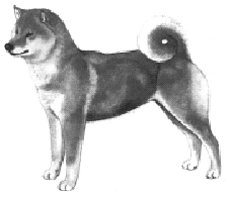Shiba Inu
General Information - Shiba Inu

Group:
Utility
Size:
medium
Lifespan:
12-15 years
Exercise:
medium
Grooming:
medium
Trainability:
low
Watchdog ability:
very high
Protection ability:
medium
Area of Origin:
Japan
Date of Origin:
ancient times
Other Names:
Brushwood Dog, Japanese
Small-Size Dog
Original Function:
hunting and flushing
small game
History
The Shiba Inu originated in Japan around 1000 BC, making it a grand old breed. It was first used for hunting small game, and to trail larger game such as dear, boar and bear. Similar in style to the much larger Akita, its name translates from the Japanese as "small dog." Until 1920, they were considered one breed, the "Japanese Dog" and were divided according to size. Now they have separate registration.
Temperament
The Shiba Inu is an independent and strong-willed dog breed who requires consistent training. Affectionate and loyal to its owners, the Shiba Inu can be initially reserved with strangers. The Shiba Inu may not do well with cats and other small pets.
Upkeep
The Shiba Inu needs a daily workout, either in the form of a vigorous game in the yard, a long walk or a good run in a safe area. It can live outdoors in temperate or cool climates, given warm shelter, but it does best when allowed to divide its time between inside and out. Its double coat needs brushing one or two times weekly, more when shedding.
Shiba Inu
A breed standard is the guideline which describes the ideal characteristics, temperament, and appearance of a breed and ensures that the breed is fit for function with soundness essential. Breeders and judges should at all times be careful to avoid obvious conditions and exaggerations, as well as being mindful of features which could be detrimental in any way to the health, welfare or soundness of this breed.
Breed Standard - Shiba Inu
 Characteristics
Characteristics: Gifted with great agility, the Shiba Inu is a graceful and friendly dog, lively and gay but also obedient, faithful, sensitive and attentive.
General Appearance: A small dog, well shaped, compact and muscular with more of a rustic look about him than elegance. Males must be masculine and females feminine.
Size: Height at the withers - males 15 to 16 in (38.1 to 40.6 cm); females 13.7 to 15 in (35 to 38.1 cm). These size limits should be observed as strictly as possible. Larger dogs are acceptable only when in exceptional form.
Head: The forehead is wide, the median furrow pronounced; cheeks well formed; muzzle pointed, neither too short not too long. The nose is dark coloured, with a straight bridge. The teeth are solid, neither undershot not overshot. The stop is well defined but not exaggerated.
Eyes: Small, triangular in shape, dark brown.
Ears: Small, triangular, carried erect and slightly to the fore.
Forequarters: A well-developed and quite oblique shoulder. The forearms are straight, the elbows close to the body. The pasterns are very slightly inclined. The forefeet are round, with close toes. The pads are hard, the nails hard and black.
Body: The chest is deep, the ribs well rounded. The back is short and straight. The loins are wide and powerful. The belly is slightly drawn up; the genitals must be without abnormality.
Tail: Thick and strong, the tail is curled or carried as a sickle tail. It is long enough to reach the hocks when straight.
Hindquarters: Thighs and legs well developed. The hock is well directed. The feet, nails, and pads are the same basically as in the forequarters.
Coat: Hard and straight, with a fine undercoat. Colour red, salt and pepper, red-peppered, black-peppered, black, black-brown, brindle, or white. All colours must have "Urajiro", a whitish coat on the sides of the muzzle and on the cheeks, on the underside of the jaw and neck and on the chest and stomach, on the underside of the tail and on the inside of the legs.
Gait: Light, lively and energetic.
Faults: Not serious - nose different in colour from coat; slight overshot condition; teeth marked by distemper; pale eyes; long hair.
Serious Faults: distinctly overshot jaw; more than 5 teeth missing; timidity; flat ears; naturally pendant tail; short tail.
Note: Male animals should have two apparently normal testicles fully descended into the scrotum.
DNZ No 639
Copyright Dogs New Zealand
01 Jan 2002
Any departure from the foregoing points should be considered a fault and the seriousness with which the fault should be regarded should be in exact proportion to its degree and its effect upon the health and welfare of the dog and on the dog’s ability to perform its traditional work.




